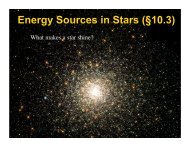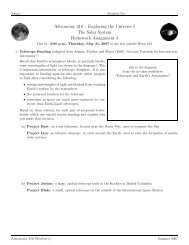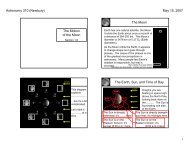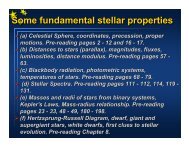Large Aperture Mirror Array (LAMA) - Astronomy and Astrophysics at ...
Large Aperture Mirror Array (LAMA) - Astronomy and Astrophysics at ...
Large Aperture Mirror Array (LAMA) - Astronomy and Astrophysics at ...
You also want an ePaper? Increase the reach of your titles
YUMPU automatically turns print PDFs into web optimized ePapers that Google loves.
The second fe<strong>at</strong>ure of the LZT is the thinness of the mercury layer. Labor<strong>at</strong>ory tests of liquid-mirrors 11 indic<strong>at</strong>e th<strong>at</strong>surface waves, induced by vibr<strong>at</strong>ions <strong>and</strong> air turbulence, essentially disappear when the thickness of the mercury film isreduced to 1 mm or less. Because a film several mm thick is required to overcome surface tension whcn starting themirror, the LZT is equipped with a pumping system capable of removing mercury from the rot<strong>at</strong>ing mirror after themercury film has stabilized <strong>and</strong> oxidized.Figure 6. The 6-m liquid mirror of the <strong>Large</strong> Zenith Telescope.Figure 7. A “first-light” image obtained with<strong>Large</strong> Zenith Telescope.Fabric<strong>at</strong>ion possibilities for the <strong>LAMA</strong> primary mirrors are presently being investig<strong>at</strong>ed. It appears likely th<strong>at</strong> these canbe most conveniently made by machining aluminum sectors. These sectors could be readily transported <strong>and</strong> assembledon site to make complete mirrors. Further details are given in an accompanying paper, in these proceedings, th<strong>at</strong>describes the <strong>LAMA</strong> Prototype Telescope 12 .7. INSTRUMENTATIONThe initial complement of instruments for <strong>LAMA</strong> would include an optical/infrared imaging camera <strong>and</strong> a highresolutionspectrograph. These would be the primary dark-time <strong>and</strong> bright-time instruments, respectively. The imagingcamera would be loc<strong>at</strong>ed <strong>at</strong> the combined focus of the array where it would be used in both incoherent <strong>and</strong> coherentimaging mode. Different images scales would be provided for these two modes in order to properly sample therespective PSFs. This camera would employ dichroic beam splitters in order to provide simultaneous broad-b<strong>and</strong>imaging, with spectral resolving power R ~ 5 over the 0.3-2.5 um wavelength range. As currently foreseen, this camerawould employ 4k x 4k CCDs for the optical channels <strong>and</strong> 2k x 2k HgCdTe arrays for the infrared channels.The high-resolution spectrograph would be designed for R ~ 300,000 spectroscopy of individual objects, such as highredshiftquasars, host stars of transiting planets, etc. It would consist of a bank of approxim<strong>at</strong>ely 10 cross-dispersed†echelle spectrographs. Each spectrograph would receive light from several individual telescopes via optical fibers. Eachfiber would sample the intermedi<strong>at</strong>e image produced by the tracking system. These images are loc<strong>at</strong>ed inside the beamcombiner room, <strong>at</strong> the entrance to the p<strong>at</strong>hlength † compens<strong>at</strong>ion systems (see Figure 3). By dividing the light between anumber of individual spectrographs, each sized for the individual <strong>LAMA</strong> telescopes, one avoids the considerabledifficulty of designing <strong>and</strong> building a high-resolution spectrograph for a 50-m telescope.










